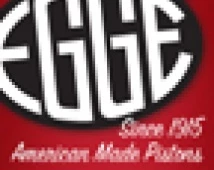History of Egge Machine Company
Founded in 1915 Egge Machine Company is a world-class piston manufacturer that specializes in domestic vehicle applications from the early 1900s to 1980. Egge operates a state-of-the-art foundry and world-class machine shop in its Santa Fe Springs, CA facility.  The Early Years
The Early Years
Founded by Edward N. Egge (known as E.N. by his friends) in Plainview, Texas in 1915 selling, servicing and repairing Mason racing cars. The small automotive machine shop did more than just replace engine parts on vehicles of the day; it made new parts when necessary. Because of limited availability and no automotive aftermarket, replacement parts – especially pistons – were constantly in short supply and difficult to get. Egge solved both problems by making his own aluminum pistons using the sand-cast process. This commitment to his customers’ needs enabled him to meet the demand and keep his business growing.
The “Roaring Twenties” found Egge relocating his repair operation to the west coast. In 1923 Egge Machine Company moved to downtown Los Angeles, CA. Egge continued to service the cars, and trucks of a growing California population. The citrus boom was at it’s peak and Egge grew to include tractor motor parts in an effort to keep up with the changing times. In the 1940’s E.N.’s son; Nels began designing building and utilizing steel molds in conjunction with sand casting pistons the company had employed years earlier. The steel molds boosted the quality and throughput of manufacturing as well as increasing the vehicle models and years. The post-war era saw another area of growth with providing parts for Indian and Harley Davidson motorcycles. Basically, if your vehicle had a combustion engine, Egge had the parts to keep it running. “Hot Rodding” also became popular at this time and Egge was on the fringe in close proximity to Edelbrock, Iskendarian, and SoCal Speed Shop.
In the 1940’s E.N.’s son; Nels began designing building and utilizing steel molds in conjunction with sand casting pistons the company had employed years earlier. The steel molds boosted the quality and throughput of manufacturing as well as increasing the vehicle models and years. The post-war era saw another area of growth with providing parts for Indian and Harley Davidson motorcycles. Basically, if your vehicle had a combustion engine, Egge had the parts to keep it running. “Hot Rodding” also became popular at this time and Egge was on the fringe in close proximity to Edelbrock, Iskendarian, and SoCal Speed Shop.
Both of E.N.’s sons worked in the business until the late 1950’s when E.N. died at age 82. At that time, Sy Egge began Egge Marine working on marine engines. In 1958, Nels moved Egge Machine Company to Gardena, CA and continued the family tradition of manufacturing hard-to-get engine parts as well as buying new old stock (N.O.S.) parts. Nels also had other parts remanufactured to supply the parts needed to complete the engine rebuilding process. Nels purchased a large number of three-piece molds. This allowed him to continue to increase the model years of cars and trucks covered. In 1972 Nels’ son Bob Egge moved the company to its present located in Santa Fe Springs, CA where they have several buildings totaling 50,000 square feet of manufacturing, warehousing, distribution, sales, office and showroom space. Further enhancement to the manufacturing process came in the form of hydraulic molding equipment. Again, expanding the range of coverage to include ‘60’s and ‘70’s model years and expanding the throughput of product.
In 1972 Nels’ son Bob Egge moved the company to its present located in Santa Fe Springs, CA where they have several buildings totaling 50,000 square feet of manufacturing, warehousing, distribution, sales, office and showroom space. Further enhancement to the manufacturing process came in the form of hydraulic molding equipment. Again, expanding the range of coverage to include ‘60’s and ‘70’s model years and expanding the throughput of product.
Bob Egge and his sister Kathryn Weaver are third generation owners who have recently handed the management reigns over to Ernie Silvers, CEO to manage the company to a new century of growth on the heels of their 93+ year family tradition of excellence, fulfilling a legacy begun by their grandfather a long time ago – striving to remain the world’s source for obsolete engine parts. Today the operation has expanded with valve manufacturing, oil, fuel, and water pump remanufacturing, Timing case rebuilding, babbitt bearing work, and now offering engine building and machining work.
Today the operation has expanded with valve manufacturing, oil, fuel, and water pump remanufacturing, Timing case rebuilding, babbitt bearing work, and now offering engine building and machining work.
Old school craftsmanship and modern technology.
Egge’s manufacturing facility has three cells with CNC machines including a 5-axis Vertical Machining Center which does the job of 6 different manual machines thus allowing less opportunity for mistakes and creating consistent quality products. From the foundry the raw piston is placed in a CNC Lathe to clean the top, and mill the ring grooves. From there the piston goes to the 5-axis CNC to drill the oil holes, horizontal slots, t-slots and holes, finish bore the pin diameter with in .0003 to .0004” specs and machine the lock ring groove where appropriate.
This long-term commitment to growth, excellence and quality enables a continued existence in an ever-changing marketplace.

